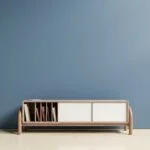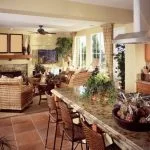Are you looking to bring a touch of nature into your home decor? In this article, we will explore the concept of incorporating biophilic design into home interiors. From understanding what biophilic design is to the benefits it offers, as well as practical decorating ideas and case studies, we will delve into how you can create a bio-inspired living space that promotes a connection with nature.
Biophilic design is a term that has been gaining traction in the world of interior design and home decor. It focuses on integrating natural elements such as plants, natural light, and even sustainable materials to create spaces that enhance our well-being and connection to the natural world. As more people seek to bring a sense of calm and tranquility into their homes, biophilic design offers a compelling approach to achieving this.
In today’s fast-paced world, the significance of incorporating elements of nature into our living spaces cannot be overstated. From improving air quality to reducing stress and promoting overall well-being, biophilic design has numerous benefits for homeowners. Whether you’re looking to revamp your living room or create a serene bedroom retreat, embracing biophilic design principles can truly transform your home decor experience.
Understanding Biophilic Design
Biophilic design is a concept that has gained significant attention in the world of home decor in recent years. It revolves around the idea of incorporating natural elements and materials into interior spaces to create a connection with nature. This design approach emphasizes the importance of bringing the outdoors indoors, creating harmonious and sustainable living environments.
Understanding biophilic design is essential for those looking to create a natural and balanced atmosphere within their homes. Essentially, biophilic design seeks to mimic natural environments within interior spaces, promoting improved well-being and productivity.
This approach involves integrating organic shapes, natural light, and plant life into home decor to evoke a sense of tranquility and harmony. Moreover, biophilic design is not just about aesthetics; it also takes into consideration the sustainability and environmental impact of materials used in home decor.
The significance of biophilic design in home decor cannot be overstated. Research has shown that incorporating natural elements into living spaces can have a positive impact on mental health by reducing stress, enhancing cognitive function, and boosting overall mood.
Furthermore, embracing biophilic design principles can lead to a more sustainable lifestyle by encouraging the use of eco-friendly materials and fostering a deeper appreciation for nature’s beauty within the home environment. By understanding the importance of biophilic design, individuals can create living spaces that are not only visually appealing but also contribute to their well-being and that of the planet.
- Increased connection with nature
- Promotion of well-being
- Enhanced sustainability
Benefits of Biophilic Design
Biophilic design, which emphasizes the connection between humans and nature, has been gaining popularity in the world of home decor. By incorporating natural elements into interior spaces, homeowners can experience a wide range of benefits that positively impact their overall well-being.
Some of the key benefits of biophilic design for home decor include:
1. Improved Mental Well-being: Bringing nature indoors can have a calming and stress-reducing effect on individuals. Natural elements such as plants, natural light, and organic materials can create a tranquil environment that promotes relaxation and mental clarity.
2. Enhanced Physical Health: Biophilic design can also contribute to better physical health. For example, incorporating indoor plants can improve air quality by reducing toxins and increasing oxygen levels, creating a healthier living environment for occupants.
3. Increased Productivity: Studies have shown that exposure to natural elements at home can enhance cognitive function and productivity. By integrating biophilic elements into home decor, individuals may experience improved focus and creativity in their daily activities.
In addition to these benefits, embracing biophilic design in home decor can also foster a stronger connection with the natural world, promote sustainability, and serve as a visual reminder of the beauty of nature within the comfort of one’s home.
Biophilic Decorating Ideas
Bringing Nature Inside
One way to incorporate biophilic design into home decor is by bringing nature inside. This can be achieved through the use of indoor plants, natural materials such as wood and stone, and even water features. Indoor plants not only add a touch of greenery but also improve air quality and create a calming atmosphere. Using natural materials like wood for furniture or stone for accent pieces can bring an organic feel to the space.
Natural Light and Ventilation
Another aspect to consider when implementing biophilic design is maximizing natural light and airflow within the home. This can be achieved by strategically placing windows, using sheer curtains, or opting for light-colored walls to reflect more sunlight. Natural light not only illuminates the space but also creates a feeling of openness and connection to the outdoors.
Nature-Inspired Art and Decor
Incorporating bio-inspired elements into home decor can also involve using nature-themed art and decor to bring the outdoors inside. This can include landscape paintings, botanical prints, or decorative items made from natural materials such as woven baskets or driftwood sculptures. These nature-inspired elements add visual interest while fostering a connection to the natural world within the confines of indoor living spaces.
By incorporating these biophilic decorating ideas into home decor, individuals can create a sense of tranquility and harmony within their living spaces while reaping the benefits of being in touch with nature on a daily basis.
Choosing Bio-Friendly Materials
When it comes to biophilic design in home decor, one of the key aspects to consider is the use of eco-friendly and sustainable materials. In today’s world, there is a growing awareness of the environmental impact of our choices, including the materials we use in our homes. Choosing bio-friendly materials not only contributes to a healthier environment, but it also adds a unique aesthetic appeal to interior spaces.
Understanding Eco-Friendly Materials
Eco-friendly materials are those that have been sourced and produced in a sustainable manner, with minimal impact on the environment. This can include materials such as bamboo, cork, reclaimed wood, recycled glass, and natural fibers like organic cotton or jute. These materials are often renewable, biodegradable, or made from recycled sources, making them an ideal choice for environmentally-conscious home decor.
Benefits of Using Sustainable Materials
Incorporating eco-friendly materials into home decor not only reduces the carbon footprint but also promotes better indoor air quality. Many traditional building and decorating materials contain harmful chemicals that can off-gas over time, leading to indoor air pollution. By choosing sustainable materials for furniture, flooring, textiles, and accessories, homeowners can create a healthier indoor environment for themselves and their families.
Inspiring Biophilic Design With Sustainable Materials
Using eco-friendly and sustainable materials in home decor doesn’t mean sacrificing style or creativity. In fact, it opens up a world of design possibilities, from rustic reclaimed wood furniture to sleek bamboo flooring and organic linen curtains. By incorporating these bio-friendly elements into interior design, homeowners can create spaces that connect them with nature while also making a positive impact on the planet.
Bringing Nature Indoors
Incorporating natural elements and greenery into home interiors is an essential aspect of biophilic design. This design concept seeks to connect humans with nature, promoting well-being and a sense of calmness within indoor spaces. By bringing the outdoors inside, homeowners can create a more harmonious and relaxing environment that mimics the beauty of the natural world.
One of the key benefits of integrating natural elements and greenery into home interiors is the improvement in air quality. Plants have the ability to purify the air by absorbing toxins and releasing oxygen, creating a healthier living environment for occupants. Additionally, having greenery indoors can contribute to reducing stress, boosting creativity, and enhancing overall mental well-being.
There are various ways to introduce natural elements and greenery into home interiors. From large potted plants as focal points in living rooms to small succulents on tabletops, there are numerous options for incorporating greenery. Moss walls, vertical gardens, and indoor water features are also popular choices for bringing nature indoors. Moreover, using natural materials such as wood, stone, or bamboo in furniture and decor items can further enhance the biophilic atmosphere within a home.
| Benefits of Bringing Nature Indoors | Ways to Introduce Natural Elements |
|---|---|
| Improves air quality | Potted plants as focal points |
| Reduces stress | Succulents on tabletops |
| Enhances mental well-being | Moss walls and vertical gardens |
Biophilic Color Palette
Incorporating biophilic design into home decor involves incorporating natural elements and creating a connection to the outdoors. One of the key aspects of biophilic decorating is the use of earthy tones and natural colors to bring the calm and serenity of nature indoors. By utilizing a biophilic color palette, homeowners can create a relaxing and harmonious environment within their living spaces.
The use of earthy tones such as greens, browns, and warm neutrals can evoke a sense of tranquility and wellbeing. These colors are often found in natural surroundings, such as forests, mountains, and beaches, making them perfect for creating an organic and soothing atmosphere in the home. Additionally, natural colors like shades of blue, soft yellows, and soft whites can further enhance the connection to nature within interior spaces.
When considering a biophilic color palette for home decor, it’s essential to choose hues that resonate with personal preferences while promoting relaxation and comfort. Whether it’s through wall paint, furniture upholstery, or accessories such as throw pillows and rugs, integrating earthy tones and natural colors can transform any room into a sanctuary that nurtures both physical and mental well-being.
Integrating natural elements into home interiors is a fundamental aspect of biophilic design. The use of greenery as part of interior decor not only adds aesthetic appeal but also has numerous health benefits. Indoor plants not only improve air quality by releasing oxygen but also have been shown to reduce stress levels and increase productivity.
In home decor inspired by biophilic design, bringing nature indoors can be achieved through incorporating houseplants strategically throughout living spaces. Whether it’s hanging pots from ceiling hooks or displaying succulents on shelves or tabletops, adding greenery can instantly create a refreshing ambiance within the home. Additionally, featuring natural materials such as wood furniture or stone accents further enhances the connection to nature within interior spaces.
Ultimately, integrating natural elements into home decor reflects our innate desire to be connected with the natural world. By fostering this connection through design choices that embrace biophilia, homeowners can create living spaces that promote relaxation while also supporting overall well-being.
| Biophilic Color Palette Ideas | Bringing Nature Indoors |
|---|---|
| Incorporate green accent walls | Add indoor plants strategically throughout living spaces |
| Use natural textiles in earthy tones for throws and cushions | Feature wooden furniture pieces |
| Opt for light-colored flooring resembling sand or pebbles | Utilize stone accents in decor options |
Case Studies
In order to truly understand the impact of biophilic design on home decor, it is important to look at real-life examples of how this concept has transformed living spaces. By showcasing specific case studies, we can see the tangible benefits and visual appeal of incorporating natural elements into interior design.
One example of successful biophilic home design is a modern urban apartment that seamlessly integrates natural elements such as wood, stone, and abundant greenery. The use of large windows allows for ample natural light to flood the space, creating a connection to the outdoors. By bringing nature indoors, the apartment becomes a peaceful sanctuary in the midst of a bustling city.
Another case study focuses on a suburban family home that embraces biophilic design principles. The use of organic materials like bamboo flooring, reclaimed wood furniture, and indoor plants creates a sense of harmony and tranquility throughout the residence. This bio-friendly approach not only enhances the aesthetic appeal of the home but also promotes a healthier living environment for the family members.
A third case study showcases a coastal retreat that incorporates biophilic design to create a calming and restorative atmosphere. Through the strategic use of an earthy color palette, natural textures, and views of the surrounding landscape, this home blurs the boundaries between indoor and outdoor living. The result is a space that feels connected to its natural surroundings, inviting inhabitants to relax and rejuvenate.
These real-life examples demonstrate how biophilic design can significantly impact the look and feel of residential spaces. By drawing inspiration from these case studies, homeowners can gain insight into practical ways to incorporate bio-inspired elements into their own home decor projects.
Conclusion
In conclusion, incorporating biophilic design into home decor goes beyond simply adding natural elements to interior spaces. It is about creating a harmonious environment that resonates with the natural world, promoting a sense of well-being and connection to the outdoors. By understanding the significance of biophilic design and its positive impact on home decor, individuals can reap a myriad of benefits that contribute to a healthier and more sustainable lifestyle.
From improving air quality to reducing stress and promoting mental clarity, the benefits of integrating bio-inspired elements into home decor are far-reaching. The use of eco-friendly and sustainable materials not only enhances the aesthetic appeal of living spaces but also contributes to environmental conservation. By bringing nature indoors through the strategic placement of greenery and natural elements, homeowners can create a tranquil sanctuary that promotes relaxation and rejuvenation.
Furthermore, the adoption of an earthy color palette adds warmth and richness to interior spaces while creating a seamless transition between indoor and outdoor environments. Real-life case studies serve as tangible examples of how embracing biophilic design has transformed home spaces, showcasing its potential to elevate both the functionality and aesthetic appeal of residential interiors.
In essence, by embracing biophilic design in home decor, individuals can foster a deeper connection with nature while creating living environments that promote health, well-being, and sustainability.
Frequently Asked Questions
What Is a Good Bio for an Interior Designer?
A good bio for an interior designer should highlight your unique design style, experience, and qualifications. It should also showcase your personality and passion for creating beautiful and functional spaces to give potential clients a sense of who you are as a designer.
How Do I Write About Myself as an Interior Designer?
When writing about yourself as an interior designer, focus on your design philosophy, what inspires you, and how you approach each project. Share your expertise in specific styles or areas of design, any awards or recognitions, and the impact you’ve made in the industry.
How Do You Write an Interior Design Caption?
To write an interior design caption, think about the mood or message you want to convey about the space. Use descriptive language to evoke images and emotions related to the design. Consider incorporating design elements or principles that make the space unique and visually appealing. Keep it concise yet impactful.

I’m thrilled to be your companion on this exciting journey through the world of home decor and design. With a passion for turning houses into homes and a keen eye for the finer details, I’m here to help you transform your living spaces into beautiful, functional, and meaningful havens.





